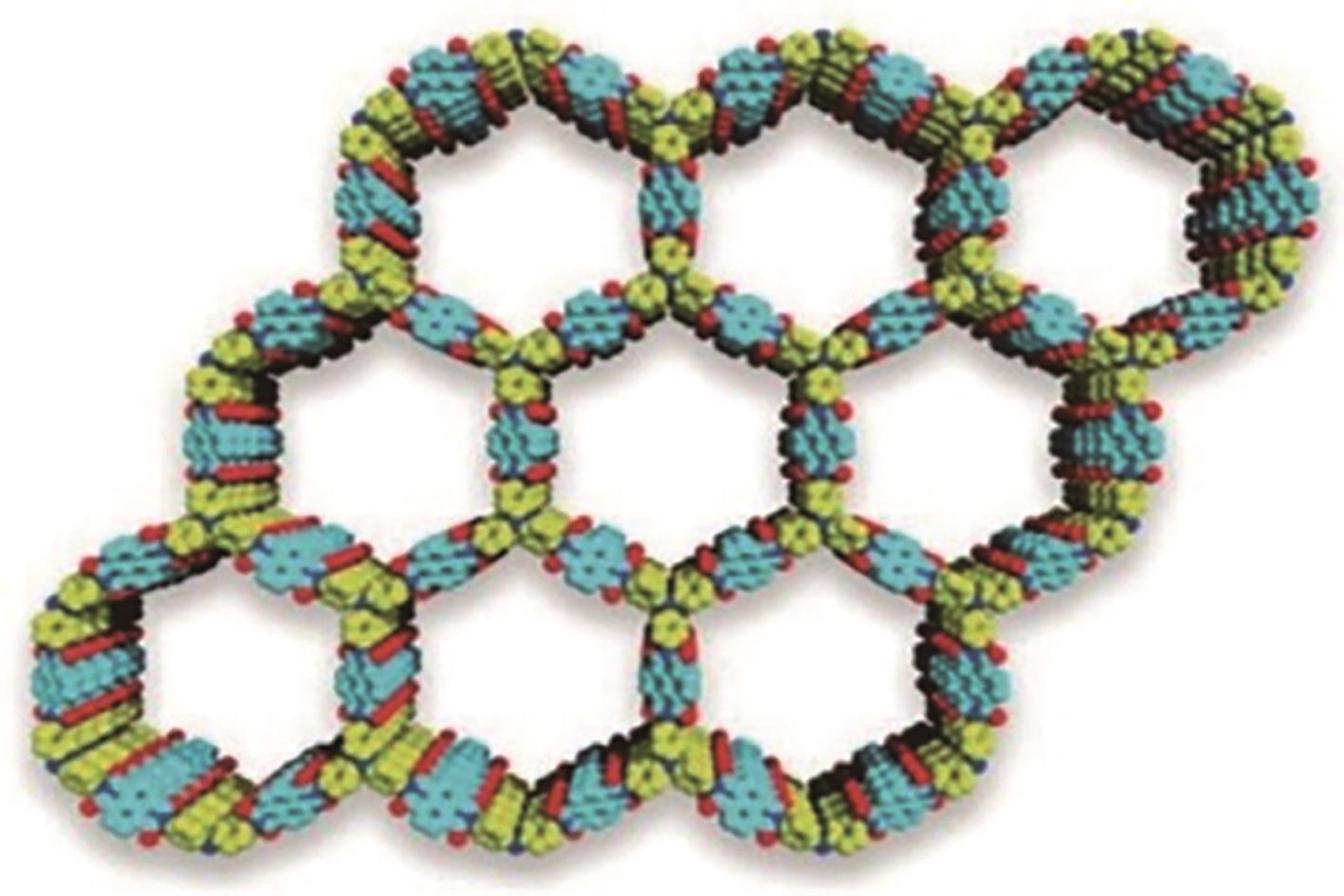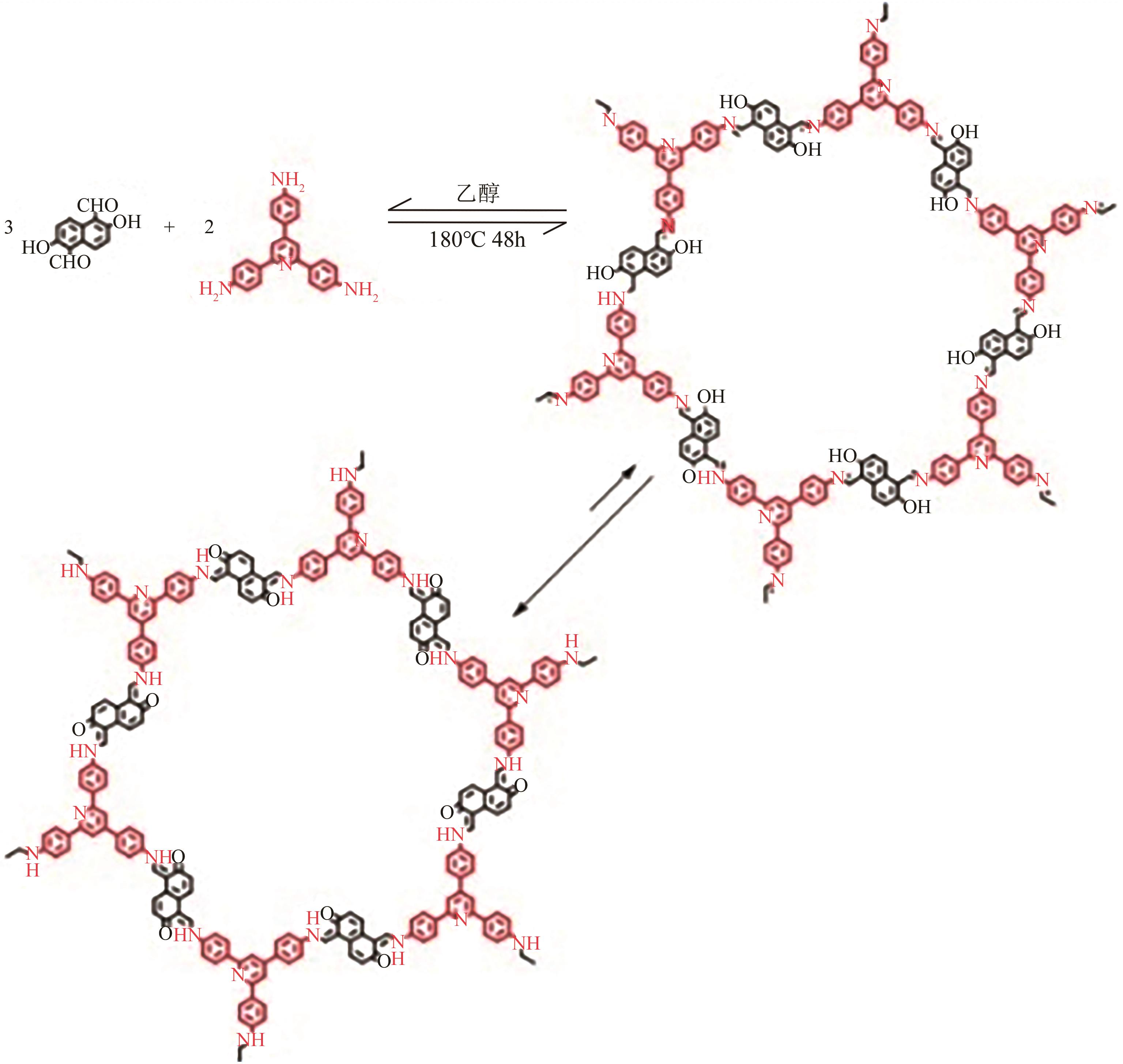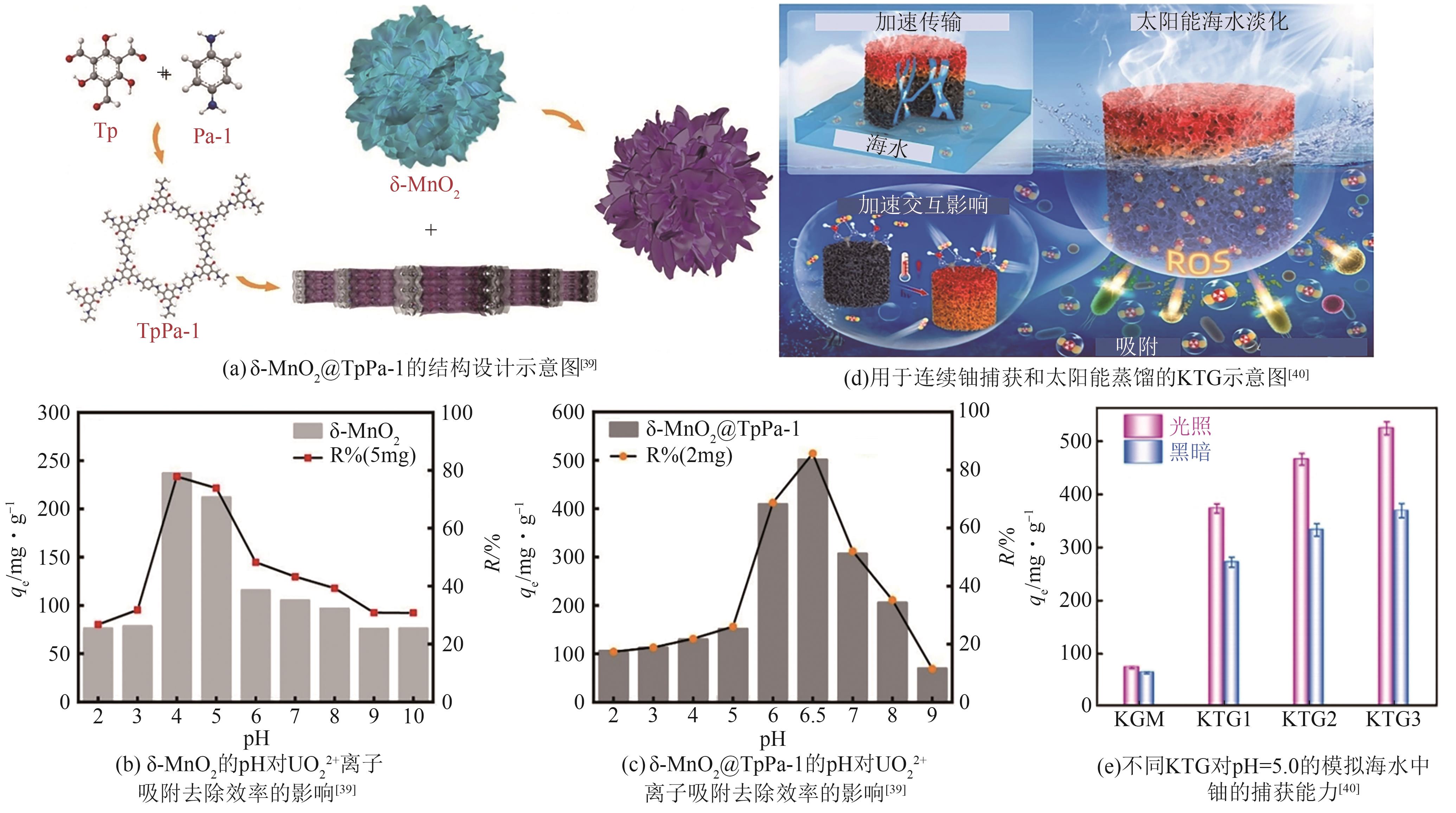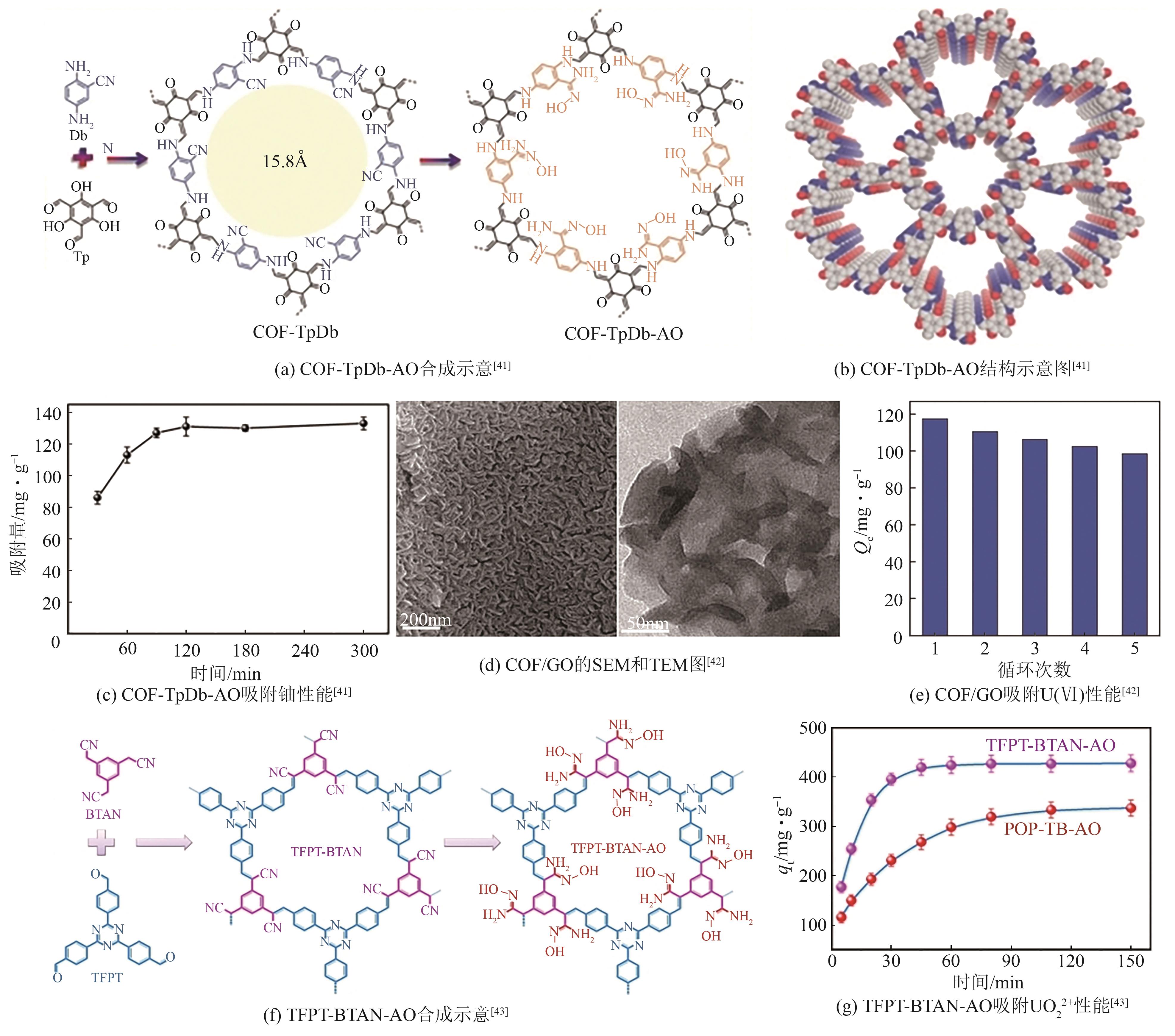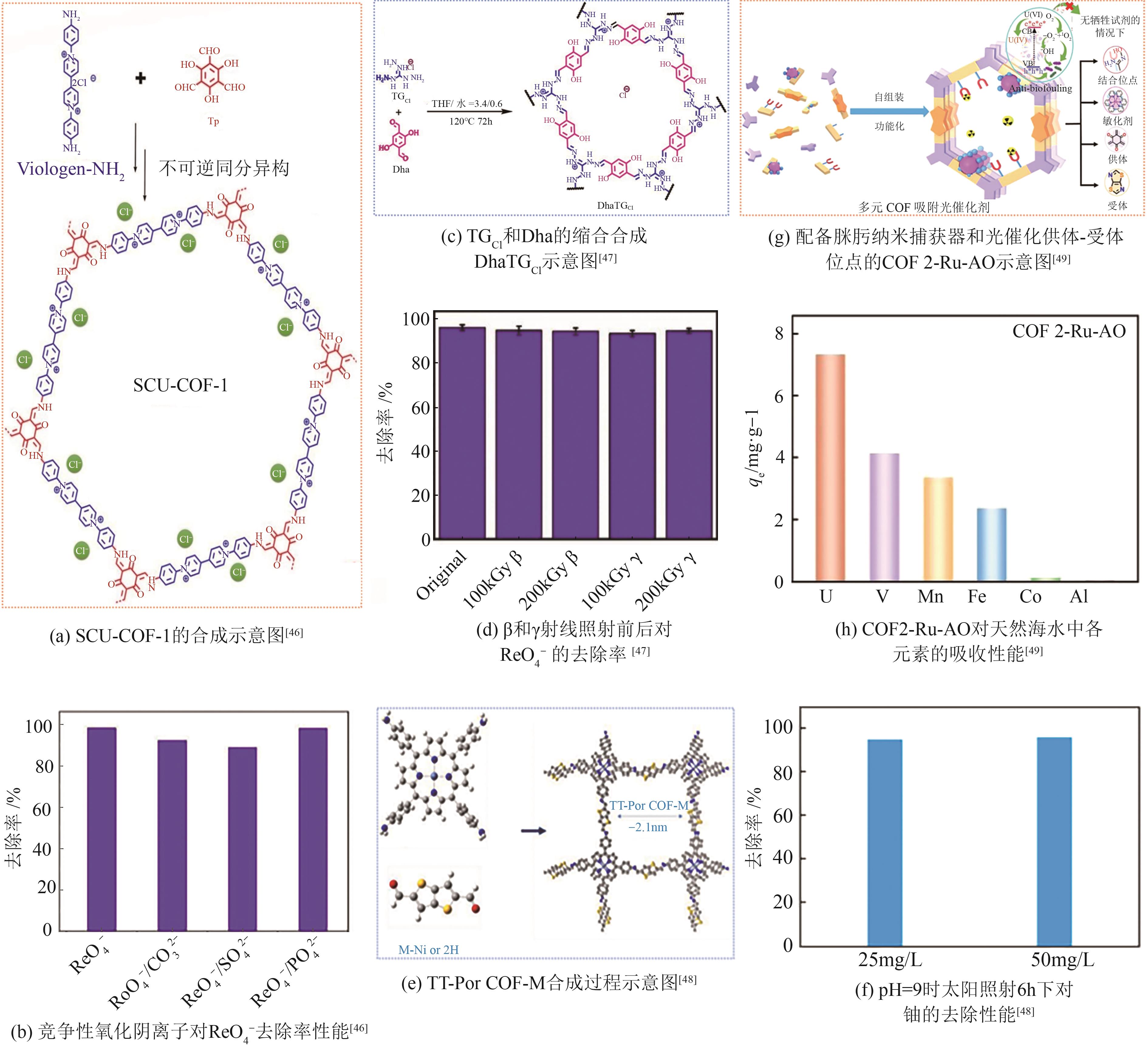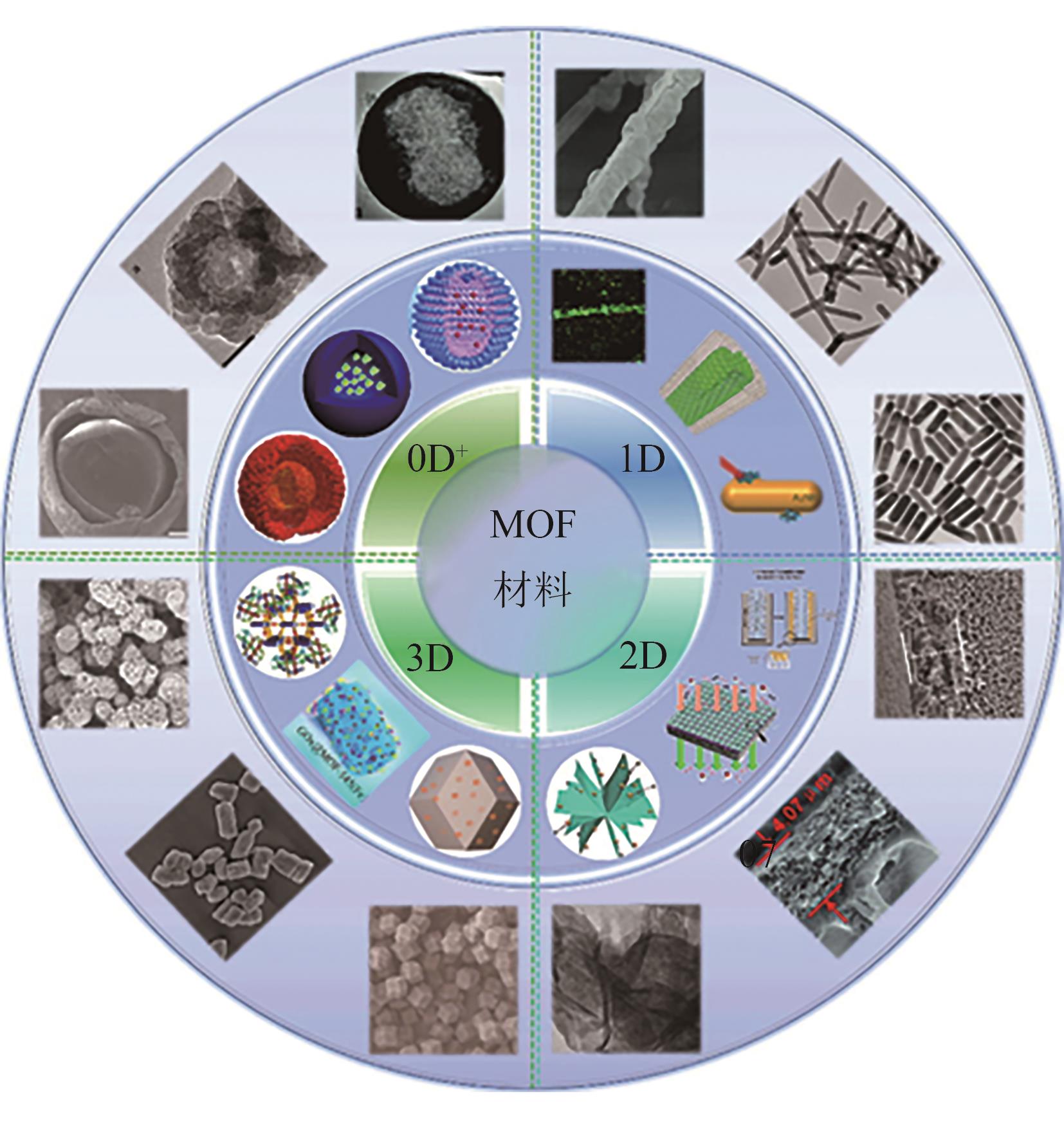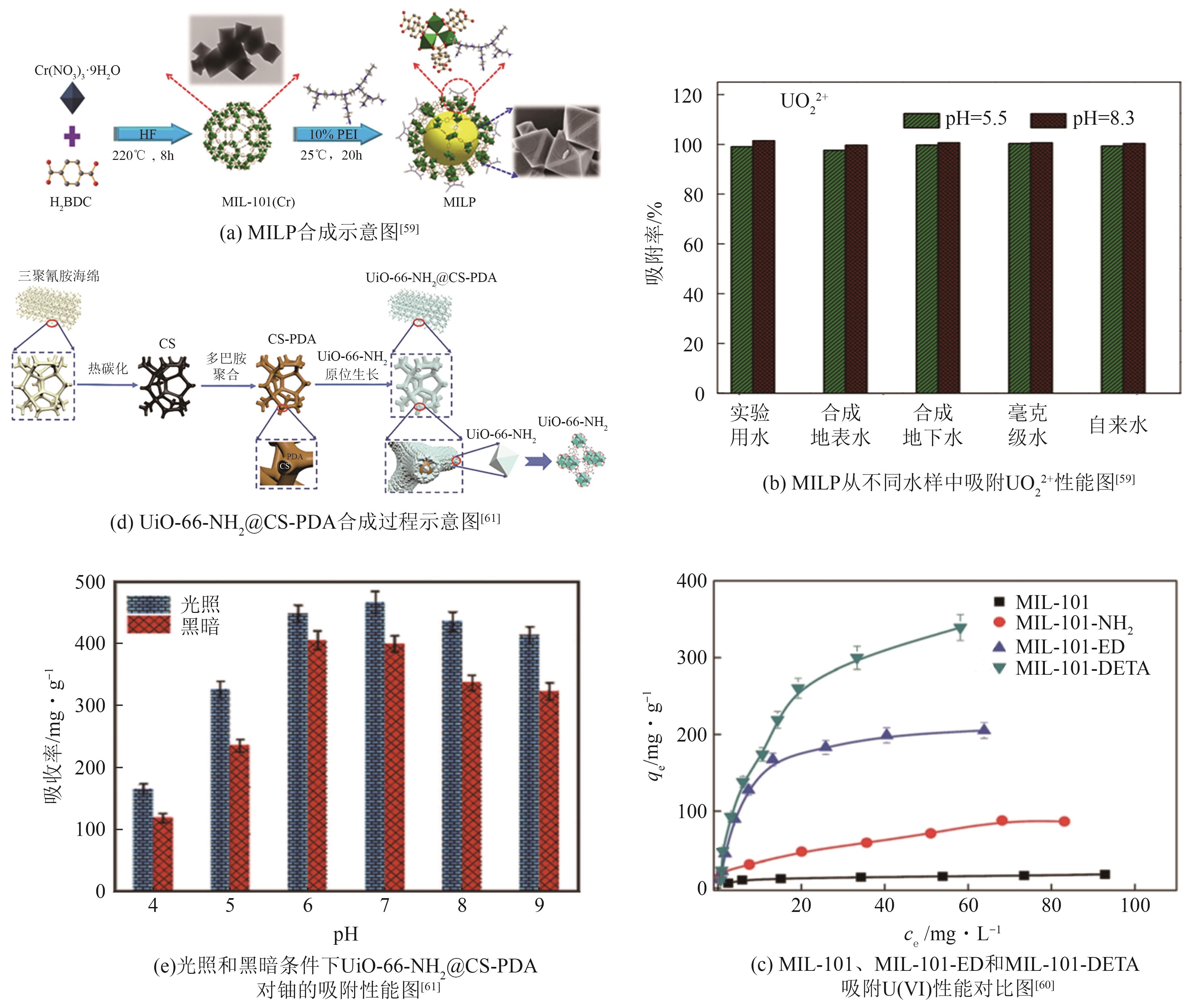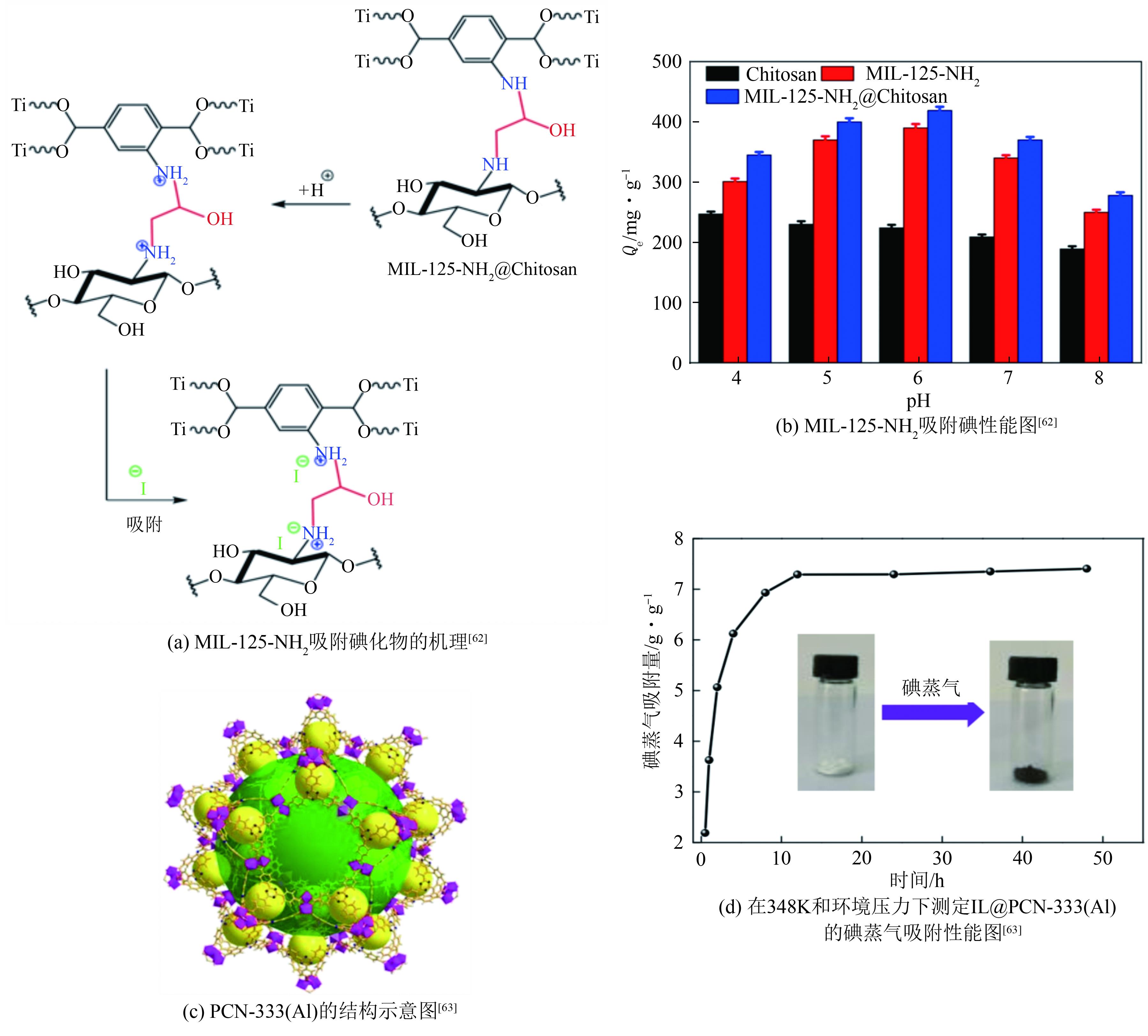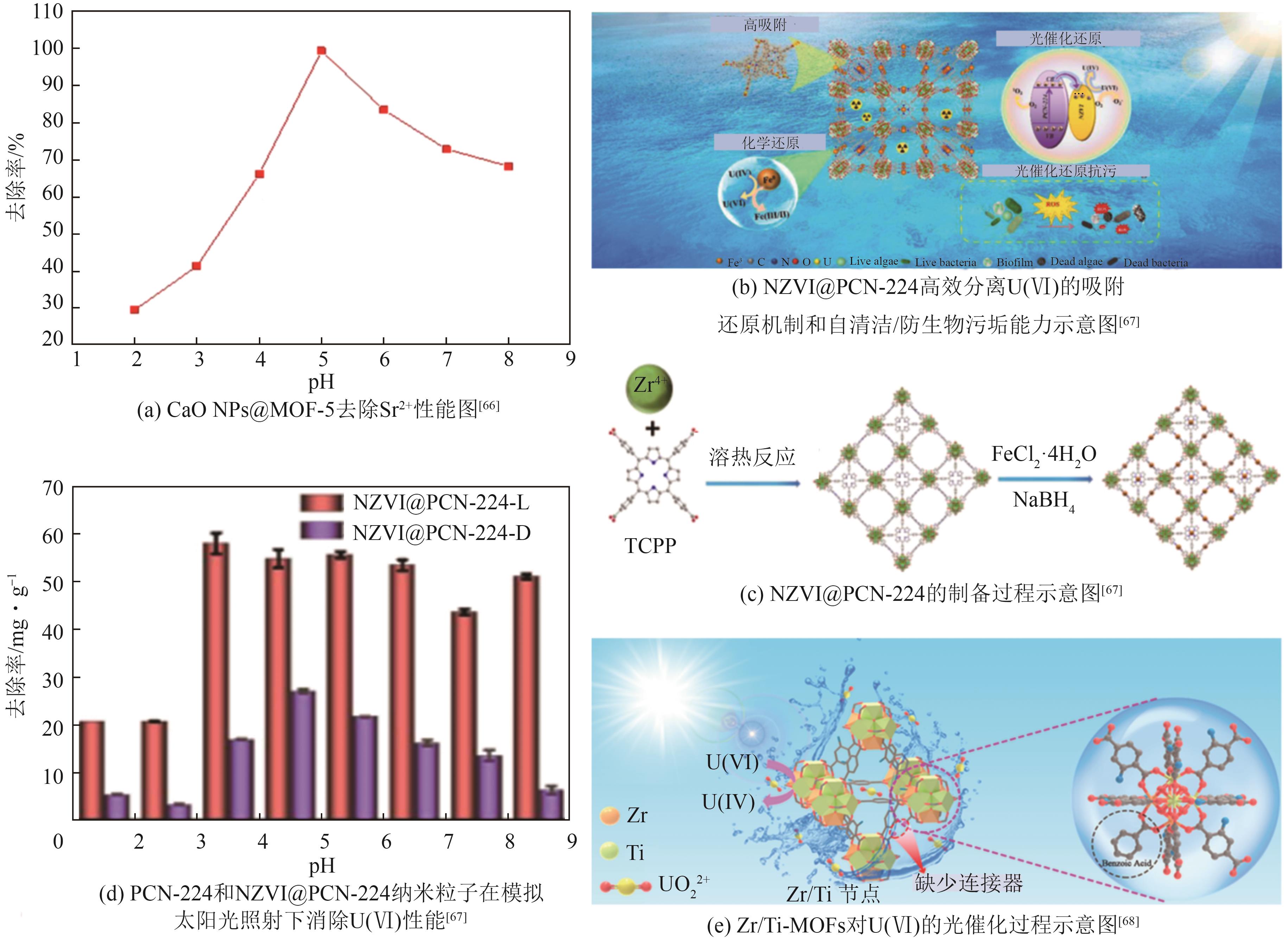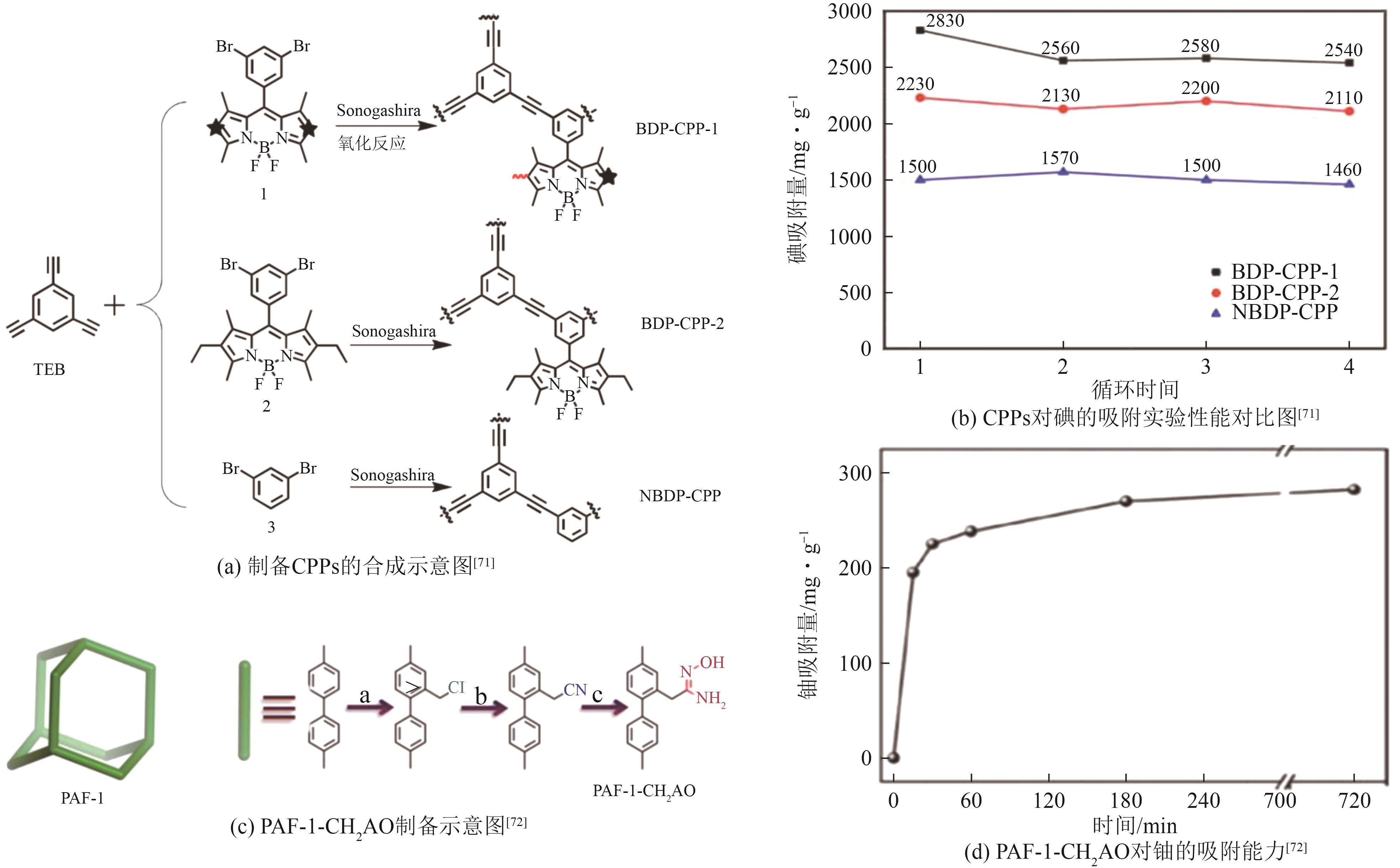Chemical Industry and Engineering Progress ›› 2025, Vol. 44 ›› Issue (1): 354-366.DOI: 10.16085/j.issn.1000-6613.2024-0095
• Materials science and technology • Previous Articles Next Articles
Progress in the study of porous materials for radionuclide adsorption in wastewater
JIAO Rui( ), ZHOU Tao(
), ZHOU Tao( ), SUN Hanxue, LI Jiyan, ZHU Zhaoqi, LI An(
), SUN Hanxue, LI Jiyan, ZHU Zhaoqi, LI An( )
)
- School of Petrochemical Engineering, Lanzhou University of Technology, Lanzhou 730050, Gansu, China
-
Received:2024-01-14Revised:2024-04-16Online:2025-02-13Published:2025-01-15 -
Contact:LI An
多孔材料用于废水中放射性核素吸附的研究进展
焦芮( ), 周涛(
), 周涛( ), 孙寒雪, 李吉焱, 朱照琪, 李安(
), 孙寒雪, 李吉焱, 朱照琪, 李安( )
)
- 兰州理工大学石油化工学院,甘肃 兰州 730050
-
通讯作者:李安 -
作者简介:焦芮(1993—),女,讲师,博士,研究方向为微纳孔材料的制备及其在放射性元素吸附领域应用。E-mail:jiaorui@lut.edu.cn。
周涛(2000—),男,硕士研究生,研究方向为微纳孔材料在放射性元素吸附领域应用。E-mail:zt1181439095@163.com。 -
基金资助:国家自然科学基金(22006061)
CLC Number:
Cite this article
JIAO Rui, ZHOU Tao, SUN Hanxue, LI Jiyan, ZHU Zhaoqi, LI An. Progress in the study of porous materials for radionuclide adsorption in wastewater[J]. Chemical Industry and Engineering Progress, 2025, 44(1): 354-366.
焦芮, 周涛, 孙寒雪, 李吉焱, 朱照琪, 李安. 多孔材料用于废水中放射性核素吸附的研究进展[J]. 化工进展, 2025, 44(1): 354-366.
share this article
Add to citation manager EndNote|Ris|BibTeX
URL: https://hgjz.cip.com.cn/EN/10.16085/j.issn.1000-6613.2024-0095
| 处理技术 | 特点 | 局限性 | 参考文献 |
|---|---|---|---|
| 化学沉淀 | 工艺简单、成本低、适用范围广 | 固液分离困难、污泥量大、会造成二次污染 | [ |
| 离子交换 | 具有良好的化学稳定性、热稳定性和辐射稳定性 | 无法用于处理高浓度放射性废水;难以循环利用 | [ |
| 膜分离技术 | 净化系数高、浓缩量大、能耗低、系统简单、操作灵活 | 材料的成膜性较难;膜寿命较短 | [ |
| 蒸发浓缩 | 净化系数和体积减量效果高、灵活性大、应用范围广、能够与各种技术相结合 | 热利用率低,价格昂贵;不适用于处理含有挥发性核素的废液;处理酸性高放废液时,随着酸浓度的增加,沸点升高,效率降低,设备腐蚀性增加 | [ |
| 物理吸附 | 吸附材料种类多,可根据不同放射性核素的性质选择与之相对应的吸附剂 | 材料再生性能差、成本高 | [ |
| 处理技术 | 特点 | 局限性 | 参考文献 |
|---|---|---|---|
| 化学沉淀 | 工艺简单、成本低、适用范围广 | 固液分离困难、污泥量大、会造成二次污染 | [ |
| 离子交换 | 具有良好的化学稳定性、热稳定性和辐射稳定性 | 无法用于处理高浓度放射性废水;难以循环利用 | [ |
| 膜分离技术 | 净化系数高、浓缩量大、能耗低、系统简单、操作灵活 | 材料的成膜性较难;膜寿命较短 | [ |
| 蒸发浓缩 | 净化系数和体积减量效果高、灵活性大、应用范围广、能够与各种技术相结合 | 热利用率低,价格昂贵;不适用于处理含有挥发性核素的废液;处理酸性高放废液时,随着酸浓度的增加,沸点升高,效率降低,设备腐蚀性增加 | [ |
| 物理吸附 | 吸附材料种类多,可根据不同放射性核素的性质选择与之相对应的吸附剂 | 材料再生性能差、成本高 | [ |
| 1 | ALAGUMALAI K, HA J H, CHOI S S. Recent advances in the removal of radioactive wastes containing 58Co and 90Sr from aqueous solutions using adsorption technology[J]. Industrial Chemistry, 2022, 33(4): 352-366. |
| 2 | OSMANLIOGLU Ahmet E. Decontamination of radioactive wastewater by two-staged chemical precipitation[J]. Nuclear Engineering and Technology, 2018, 50(6): 886-889. |
| 3 | MA Hailing, SHEN Minghai, TONG Yao, et al. Radioactive wastewater treatment technologies: A review[J]. Molecules, 2023, 28(4): 1935-1959. |
| 4 | SYLVESTER Paul, MILNER Tim, JENSEN Jesse. Radioactive liquid waste treatment at Fukushima Daiichi[J]. Journal of Chemical Technology & Biotechnology, 2013, 88(9): 1592-1596. |
| 5 | LUO Xin, ZHANG Guanghui, WANG Xue, et al. Research on a pellet co-precipitation micro-filtration process for the treatment of liquid waste containing strontium[J]. Journal of Radioanalytical and Nuclear Chemistry, 2013, 298(2): 931-939. |
| 6 | LI Shicheng, HE Zhengzhong, XIAO Detao, et al. Study on the treatment of radioactive wastewater by non-contact membrane distillation[J]. Separation and Purification Technology, 2022, 290: 120766. |
| 7 | FIGUEIREDO Bruno R, CARDOSO Simão P, PORTUGAL Inês, et al. Inorganic ion exchangers for cesium removal from radioactive wastewater[J]. Separation & Purification Reviews, 2018, 47(4): 306-336. |
| 8 | WANG Chao, WANG Yian, QIN Hui, et al. Application of microfiltration membrane technology in water treatment[J]. IOP Conference Series: Earth and Environmental Science, 2020, 571(1): 012158. |
| 9 | Grażyna ZAKRZEWSKA-TRZNADEL. Advances in membrane technologies for the treatment of liquid radioactive waste[J]. Desalination, 2013, 321: 119-130. |
| 10 | SI Zetian, HAN Dong, XIANG Jiawei. Experimental investigation on the mechanical vapor recompression evaporation system coupled with multiple vacuum membrane distillation modules to treat industrial wastewater[J]. Separation and Purification Technology, 2021, 275: 119178. |
| 11 | Hee-Chul EUN, CHANG Na-On, LEE Song-bok, et al. A study on treatment of strong acidic wastewater containing a high concentration of a nonionic surfactant and ionic materials with radioactive nuclides[J]. Water, Air, & Soil Pollution, 2022, 233(9): 360-368. |
| 12 | GROMOV V F, IKIM M I, GERASIMOV G N, et al. Crown ethers: Selective sorbents of radioactive and heavy metals[J]. Russian Journal of Physical Chemistry B, 2021, 15(1): 140-152. |
| 13 | XUAN Sensen, ZHANG Bo, XIAO Lin, et al. Facile carboxylation of natural eggshell membrane for highly selective U(Ⅵ) adsorption from radioactive wastewater[J]. Environmental Science and Pollution Research, 2021, 28(33): 45134-45143. |
| 14 | HUANG Lei, LUO Zhixuan, HUANG Xuexia, et al. Applications of biomass-based materials to remove fluoride from wastewater: A review[J]. Chemosphere, 2022, 301: 134679. |
| 15 | FANG Xianghong, XU Zhonghui, LUO Yaodong, et al. Removal of radionuclides from laundry wastewater containing organics and suspended solids using inorganic ion exchanger[J]. Procedia Environmental Sciences, 2016, 31: 375-381. |
| 16 | LIU Weifeng, ZHANG Jian, CHENG Cheng, et al. Ultrasonic-assisted sodium hypochlorite oxidation of activated carbons for enhanced removal of Co(Ⅱ) from aqueous solutions[J]. Chemical Engineering Journal, 2011, 175: 24-32. |
| 17 | MEKAWY Zakaria A, SHAZLY Ehab A A EL, MAHMOUD Mamdoh R. Utilization of bentonite as a low-cost adsorbent for removal of 95Zr(Ⅳ), 181Hf(Ⅳ) and 95Nb(Ⅴ) radionuclides from aqueous solutions[J]. Journal of Radioanalytical and Nuclear Chemistry, 2022, 331(9): 3935-3948. |
| 18 | LI Yang, GUO Xinghua, LI Xiaofeng, et al. Redox-active two-dimensional covalent organic frameworks (COFs) for selective reductive separation of valence-variable, redox-sensitive and long-lived radionuclides[J]. Angewandte Chemie International Edition, 2020, 59(10): 4168-4175. |
| 19 | GENDY Eman Abdelnasser, OYEKUNLE Daniel Temitayo, Jawad ALI, et al. High-performance removal of radionuclides by porous organic frameworks from the aquatic environment: A review[J]. Journal of Environmental Radioactivity, 2021, 238: 106710. |
| 20 | LI Baoning, ZHANG Xinglong, BAI Xiaohui, et al. Electron-rich triazine-conjugated microporous polymers for the removal of dyes from wastewater[J]. Molecules, 2023, 28(12): 4785. |
| 21 | FU Xiaohua, SONG Xinyu, ZHENG Qingxing, et al. Frontier materials for adsorption of antimony and arsenic in aqueous environments: A review[J]. International Journal of Environmental Research and Public Health, 2022, 19(17): 10824. |
| 22 | PARLAPIANO Marco, Çağrı AKYOL, FOGLIA Alessia, et al. Selective removal of contaminants of emerging concern (CECs) from urban water cycle via molecularly imprinted polymers (MIPs): Potential of upscaling and enabling reclaimed water reuse[J]. Journal of Environmental Chemical Engineering, 2021, 9(1): 105051. |
| 23 | DELKASH Madjid, BAKHSHAYESH Babak Ebeazi, KAZEMIAN Hossein. Using zeolitic adsorbents to cleanup special wastewater streams: A review[J]. Microporous and Mesoporous Materials, 2015, 214: 224-241. |
| 24 | 徐杨, 王鹏, 赵敏, 等. 用于放射性核素吸附分离的有机多孔材料研究进展[J]. 原子能科学技术, 2019, 53(10): 1773-1787. |
| XU Yang, WANG Peng, ZHAO Min, et al. Advance in porous organic adsorbent for radionuclide adsorption and separation[J]. Atomic Energy Science and Technology, 2019, 53(10): 1773-1787. | |
| 25 | HAN Jin, QIU Taolei, WU Dan, et al. Upcycling of polyphenylene ether waste products to hypercrosslinked organic porous materials[J]. Materials Today Communications, 2023, 34: 105489. |
| 26 | ZHANG Ning, ISHAG Alhadi, LI Ying, et al. Recent investigations and progress in environmental remediation by using covalent organic framework-based adsorption method: A review[J]. Journal of Cleaner Production, 2020, 277: 123360. |
| 27 | Alberto LÓPEZ-MAGANO, Alicia JIMÉNEZ-ALMARZA, Jose ALEMÁN, et al. Metal-organic frameworks (MOFs) and covalent organic frameworks (COFs) applied to photocatalytic organic transformations[J]. Catalysts, 2020, 10(7): 720. |
| 28 | ZHANG Ya, HUANG Zhe, RUAN Bo, et al. Design and synthesis of polyimide covalent organic frameworks[J]. Macromolecular Rapid Communications, 2020, 41(22): 2000402. |
| 29 | DIVYA, JANGIR Ritambhara. COF-molecular sieving membrane fabrication and applications for dye separation[J]. Chemistry Select, 2023, 8(43): e202302060. |
| 30 | XIONG Shanxin, CUI Xin, GUO Jingru, et al. Triphenylamine-based covalent organic framework nanospheres: Solvothermal synthesis and electrochromic properties[J]. Journal of Electroanalytical Chemistry, 2023, 942: 117563. |
| 31 | JI Wenhua, GUO Yushuang, XIE Huimin, et al. Rapid microwave synthesis of dioxin-linked covalent organic framework for efficient micro-extraction of perfluorinated alkyl substances from water[J]. Journal of Hazardous Materials, 2020, 397: 122793. |
| 32 | DEMAZEAU Gérard, GOGLIO Graziella, LARGETEAU Alain. Solvothermal processes and the synthesis of nitrides[J]. High Pressure Research, 2008, 28(4): 497-502. |
| 33 | CHEN Yan, LI Wei, WANG Xiaohan, et al. Green synthesis of covalent organic frameworks based on reaction media[J]. Materials Chemistry Frontiers, 2021, 5(3): 1253-1267. |
| 34 | HUANG Wei, JIANG Yi, LI Xiang, et al. Solvothermal synthesis of microporous, crystalline covalent organic framework nanofibers and their colorimetric nanohybrid structures[J]. ACS Applied Materials & Interfaces, 2013, 5(18): 8845-8849. |
| 35 | HU Jiyun, HUANG Zhiyuan, LIU Yi. Beyond solvothermal: Alternative synthetic methods for covalent organic frameworks[J]. Angewandte Chemie International Edition, 2023, 62(37): e202306999. |
| 36 | CAMPBELL Neil L, CLOWES Rob, RITCHIE Lyndsey K, et al. Rapid microwave synthesis and purification of porous covalent organic frameworks[J]. Chemistry of Materials, 2009, 21(2): 204-206. |
| 37 | SUN Qi, AGUILA Briana, MA Shengqian. Opportunities of porous organic polymers for radionuclide sequestration[J]. Trends in Chemistry, 2019, 1(3): 292-303. |
| 38 | 张慧迪, 李子杰, 石伟群. 共价有机框架稳定性提高及其在放射性核素分离中的应用[J]. 化学进展, 2023, 35(3): 475-495. |
| ZHANG Huidi, LI Zijie, SHI Weiqun. The stability enhancement of covalent organic frameworks and their applications in radionuclide separation[J]. Progress in Chemistry, 2023, 35(3): 475-495. | |
| 39 | ZHONG Xin, LU Zhipeng, LIANG Wen, et al. The fabrication of 3D hierarchical flower-like δ-MnO2@COF nanocomposites for the efficient and ultra-fast removal of UO2 2+ ions from aqueous solution[J]. Environmental Science: Nano, 2020, 7(11): 3303-3317. |
| 40 | ZHANG Chengrong, CUI Weirong, NIU Chengpeng, et al. rGO-based covalent organic framework hydrogel for synergistically enhance uranium capture capacity through photothermal desalination[J]. Chemical Engineering Journal, 2022, 428: 131178. |
| 41 | SUN Qi, AGUILA Briana, EARL Lyndsey D, et al. Covalent organic frameworks as a decorating platform for utilization and affinity enhancement of chelating sites for radionuclide sequestration[J]. Advanced Materials, 2018, 30(20): 1705479. |
| 42 | WANG Hai, LIU Renrong, WANG Huifang, et al. High effective enrichment of U(Ⅵ) from aqueous solutions on versatile crystalline carbohydrate polymer-functionalized graphene oxide[J]. Dalton Transactions, 2021, 50(39): 14009-14017. |
| 43 | CUI Weirong, ZHANG Chengrong, JIANG Wei, et al. Regenerable and stable sp2 carbon-conjugated covalent organic frameworks for selective detection and extraction of uranium[J]. Nature Communications, 2020, 11(1): 436-446. |
| 44 | RUIDAS Santu, CHOWDHURY Avik, GHOSH Anirban, et al. Covalent organic framework as a metal-free photocatalyst for dye degradation and radioactive iodine adsorption[J]. Langmuir, 2023, 39(11): 4071-4081. |
| 45 | YANG Yuling, XIONG Xiaohong, FAN Yaling, et al. Insight into volatile iodine uptake properties of covalent organic frameworks with different conjugated structures[J]. Journal of Solid-State Chemistry, 2019, 279: 120979-120986. |
| 46 | HE Linwei, LIU Shengtang, CHEN Long, et al. Mechanism unravelling for ultrafast and selective 99TcO4 - uptake by a radiation-resistant cationic covalent organic framework: A combined radiological experiment and molecular dynamics simulation study[J]. Chemical Science, 2019, 10(15): 4293-4305. |
| 47 | Hongju DA, YANG Chengxiong, YAN Xiuping. Cationic covalent organic nanosheets for rapid and selective capture of perrhenate: An analogue of radioactive pertechnetate from aqueous solution[J]. Environmental Science & Technology, 2019, 53(9): 5212-5220. |
| 48 | CHEN Lang, HANG Jiahui, CHEN Bo, et al. Photocatalytic uranium removal from basic effluent by porphyrin-Ni COF as the photocatalyst[J]. Chemical Engineering Journal, 2023, 454: 140378. |
| 49 | HAO Mengjie, XIE Yinghui, LIU Xiaolu, et al. Modulating uranium extraction performance of multivariate covalent organic frameworks through donor-acceptor linkers and amidoxime nanotraps[J]. JACS Au, 2023, 3(1): 239-251. |
| 50 | AHMADIJOKANI Farhad, GHAFFARKHAH Ahmadreza, MOLAVI Hossein, et al. COF and MOF hybrids: Advanced materials for wastewater treatment[J]. Advanced Functional Materials, 2024, 34(43)2305527. |
| 51 | YAGHI O M, LI Guangming, LI Hailian. Selective binding and removal of guests in a microporous metal-organic framework[J]. Nature, 1995, 378(6558): 703-706. |
| 52 | Marta MON, BRUNO Rosaria, Jesus FERRANDO-SORIA, et al. Metal-organic framework technologies for water remediation: Towards a sustainable ecosystem[J]. Journal of Materials Chemistry A, 2018, 6(12): 4912-4947. |
| 53 | DU Yingjie, JIA Xiaotong, ZHONG Le, et al. Metal-organic frameworks with different dimensionalities: An ideal host platform for enzyme@MOF composites[J]. Coordination Chemistry Reviews, 2022, 454: 214327. |
| 54 | Pilar AMO-OCHOA, GIVAJA Gonzalo, MIGUEL Pablo J Sanz, et al. Microwave assisted hydrothermal synthesis of a novel CuI-sulfate-pyrazine MOF[J]. Inorganic Chemistry Communications, 2007, 10(8): 921-924. |
| 55 | SONG Gongjing, SHI Yuxin, JIANG Shu, et al. Recent progress in MOF-derived porous materials as electrodes for high-performance lithium-ion batteries[J]. Advanced Functional Materials, 2023, 33(42): 2303121. |
| 56 | ZHUANG Jinliang, TERFORT Andreas, Christof WÖLL. Formation of oriented and patterned films of metal-organic frameworks by liquid phase epitaxy: A review[J]. Coordination Chemistry Reviews, 2016, 307: 391-424. |
| 57 | TAO Chengan, WANG Jianfang. Synthesis of metal organic frameworks by ball-milling[J]. Crystals, 2020, 11(1): 15-35. |
| 58 | Barbara SZCZĘŚNIAK, BORYSIUK Sylwia, CHOMA Jerzy, et al. Mechanochemical synthesis of highly porous materials[J]. Materials Horizons, 2020, 7(6): 1457-1473. |
| 59 | LI Jie, ZHANG Yan, ZHOU Yi, et al. Tailored metal-organic frameworks facilitate the simultaneously high-efficient sorption of UO2 2+ and ReO4 - in water[J]. Science of the Total Environment, 2021, 799: 149468-149479. |
| 60 | BAI Zhiqiang, YUAN Liyong, ZHU Lin, et al. Introduction of amino groups into acid-resistant MOFs for enhanced U(Ⅵ) sorption[J]. Journal of Materials Chemistry A, 2015, 3(2): 525-534. |
| 61 | LIU Tao, ZHANG Xiaobin, WANG Hui, et al. Photothermal enhancement of uranium capture from seawater by monolithic MOF-bonded carbon sponge[J]. Chemical Engineering Journal, 2021, 412: 128700. |
| 62 | Mahmoud EL-SHAHAT, ABDELHAMID Ahmed E, ABDELHAMEED Reda M. Capture of iodide from wastewater by effective adsorptive membrane synthesized from MIL-125-NH2 and cross-linked chitosan[J]. Carbohydrate Polymers, 2020, 231: 115742. |
| 63 | TANG Yuanzhe, HUANG Hongliang, LI Jian, et al. IL-induced formation of dynamic complex iodide anions in IL@MOF composites for efficient iodine capture[J]. Journal of Materials Chemistry A, 2019, 7(31): 18324-18329. |
| 64 | WANG Yanlong, LIU Zhiyong, LI Yuxiang, et al. Umbellate distortions of the uranyl coordination environment result in a stable and porous polycatenated framework that can effectively remove cesium from aqueous solutions[J]. Journal of the American Chemical Society, 2015, 137(19): 6144-6147. |
| 65 | SHEHA Reda R, SHETA Sheta M, HAMOUDA Mohamed A, et al. A comprehensive study for the potential removal of 152+154Eu radionuclides using a promising modified strontium-based MOF[J]. Journal of Environmental Radioactivity, 2023, 270: 107287. |
| 66 | YEKTA Sina, SADEGHI Meysam. Investigation of the Sr2+ ions removal from contaminated drinking water using novel CaO NPs@MOF-5 composite adsorbent[J]. Journal of Inorganic and Organometallic Polymers and Materials, 2018, 28(3): 1049-1064. |
| 67 | ZHAO Jing, Chaoyi LYU, ZHANG Rui, et al. Self-cleaning and regenerable nano zero-valent iron modified PCN-224 heterojunction for photo-enhanced radioactive waste reduction[J]. Journal of Hazardous Materials, 2023, 442: 130018. |
| 68 | LIU Tao, TANG Shuai, WEI Tao, et al. Defect-engineered metal-organic framework with enhanced photoreduction activity toward uranium extraction from seawater[J]. Cell Reports Physical Science, 2022, 3: 100892. |
| 69 | QIU Feng, ZHAO Wuxue, HAN Sheng, et al. Recent advances in boron-containing conjugated porous polymers[J]. Polymers, 2016, 8(5): 191. |
| 70 | WANG Wenting, JIANG Lingchang, LI Lifen, et al. Construction of silver functionalized porous aromatic framework for selective separation of ethylene over ethane[J]. Chemical Physics Letters, 2022, 786: 139198. |
| 71 | ZHU Yunlong, JI Yajian, WANG Degao, et al. BODIPY-based conjugated porous polymers for highly efficient volatile iodine capture[J]. Journal of Materials Chemistry A, 2017, 5(14): 6622-6629. |
| 72 | LI Baiyan, SUN Qi, ZHANG Yiming, et al. Functionalized porous aromatic framework for efficient uranium adsorption from aqueous solutions[J]. ACS Applied Materials & Interfaces, 2017, 9(14): 12511-12517. |
| [1] | CHEN Qi, WANG Wentao, ZHANG Zhipeng, YAN Taihong. Progress of covalent framework for radionuclides absorption [J]. Chemical Industry and Engineering Progress, 2021, 40(S2): 241-255. |
| [2] | Zhenguo ZHANG, Mingdong ZHANG, Ping GU, Guanghui ZHANG. Progress in adsorption of radioactive strontium and cesium from aqueous solution on zeolite materials [J]. Chemical Industry and Engineering Progress, 2019, 38(04): 1984-1995. |
| Viewed | ||||||
|
Full text |
|
|||||
|
Abstract |
|
|||||
